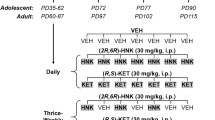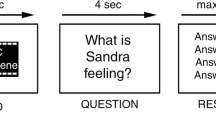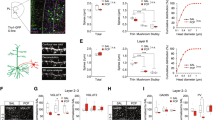Abstract
There is a need to develop treatments for cognitive impairment associated with schizophrenia (CIAS). The significant role played by N-methyl-d-aspartate receptors (NMDARs) in both the pathophysiology of schizophrenia and in neuronal plasticity suggests that facilitation of NMDAR function might ameliorate CIAS. One strategy to correct NMDAR hypofunction is to stimulate α-amino-3-hydroxy-5-methyl-4-isoxazolepropionic acid receptors (AMPARs) as AMPAR and NMDAR functioning are coupled and interdependent. In rats and nonhuman primates (NHP), AMPAR potentiators reduce spatial working memory deficits caused by the nonselective NMDAR antagonist ketamine. The current study assessed whether the AMPAR potentiator PF-04958242 would attenuate ketamine-induced deficits in verbal learning and memory in humans. Healthy male subjects (n=29) participated in two randomized treatment periods of daily placebo or PF-04958242 for 5 days separated by a washout period. On day 5 of each treatment period, subjects underwent a ketamine infusion for 75 min during which the effects of PF-04958242/placebo were assessed on ketamine-induced: (1) impairments in verbal learning and recall measured by the Hopkins Verbal Learning Test; (2) impairments in working memory on a CogState battery; and (3) psychotomimetic effects measured by the Positive and Negative Syndrome Scale and Clinician-Administered Dissociative Symptoms Scale. PF-04958242 significantly reduced ketamine-induced impairments in immediate recall and the 2-Back and spatial working memory tasks (CogState Battery), without significantly attenuating ketamine-induced psychotomimetic effects. There were no pharmacokinetic interactions between PF-04958242 and ketamine. Furthermore, PF-04958242 was well tolerated. ‘High-impact’ AMPAR potentiators like PF-04958242 may have a role in the treatment of the cognitive symptoms, but not the positive or negative symptoms, associated with schizophrenia. The excellent concordance between the preclinical (rat, NHP) and human studies with PF-04958242, and in silico modeling of AMPAR–NMDAR interactions in the hippocampus, highlights the translational value of this study.
This is a preview of subscription content, access via your institution
Access options
Subscribe to this journal
Receive 12 print issues and online access
$259.00 per year
only $21.58 per issue
Buy this article
- Purchase on Springer Link
- Instant access to full article PDF
Prices may be subject to local taxes which are calculated during checkout


Similar content being viewed by others
References
Keefe RS, Eesley CE, Poe MP . Defining a cognitive function decrement in schizophrenia. Biol Psychiatry 2005; 57: 688–691.
Heinrichs RW, Zakzanis KK . Neurocognitive deficit in schizophrenia: a quantitative review of the evidence. Neuropsychology 1998; 12: 426–445.
Green MF, Kern RS, Braff DL, Mintz J . Neurocognitive deficits and functional outcome in schizophrenia: are we measuring the 'right stuff'? Schizophr Bull 2000; 26: 119–136.
Tsang HW, Leung AY, Chung RC, Bell M, Cheung WM . Review on vocational predictors: a systematic review of predictors of vocational outcomes among individuals with schizophrenia: an update since 1998. Aust NZ J Psychiatry 2010; 44: 495–504.
Buchanan RW, Freedman R, Javitt DC, Abi-Dargham A, Lieberman JA . Recent advances in the development of novel pharmacological agents for the treatment of cognitive impairments in schizophrenia. Schizophr Bull 2007; 33: 1120–1130.
Keefe RS, Bilder RM, Davis SM, Harvey PD, Palmer BW, Gold JM et al. Neurocognitive effects of antipsychotic medications in patients with chronic schizophrenia in the CATIE Trial. Arch Gen Psychiatry 2007; 64: 633–647.
Millan MJ, Agid Y, Brune M, Bullmore ET, Carter CS, Clayton NS et al. Cognitive dysfunction in psychiatric disorders: characteristics, causes and the quest for improved therapy. Nat Rev Drug Discov 2012; 11: 141–168.
Aquila R, Citrome L . Cognitive impairment in schizophrenia: the great unmetneed. CNS Spectrums 2015; 20: 35–39, quiz 40.
D'Souza MS, Markou A . Schizophrenia and tobacco smoking comorbidity: nAChR agonists in the treatment of schizophrenia-associated cognitive deficits. Neuropharmacology 2012; 62: 1564–1573.
Bradley SR, Lameh J, Ohrmund L, Son T, Bajpai A, Nguyen D et al. AC-260584, an orally bioavailable M(1) muscarinic receptor allosteric agonist, improves cognitive performance in an animal model. Neuropharmacology 2010; 58: 365–373.
O'Donnell CJ, Rogers BN, Bronk BS, Bryce DK, Coe JW, Cook KK et al. Discovery of 4-(5-methyloxazolo[4,5-b]pyridin-2-yl)-1,4-diazabicyclo[3.2.2]nonane (CP-810,123), a novel alpha 7 nicotinic acetylcholine receptor agonist for the treatment of cognitive disorders in schizophrenia: synthesis, SAR development, and in vivo efficacy in cognition models. J Med Chem 2010; 53: 1222–1237.
Radek RJ, Kohlhaas KL, Rueter LE, Mohler EG . Treating the cognitive deficits of schizophrenia with alpha4beta2 neuronal nicotinic receptor agonists. Curr Pharm Des 2010; 16: 309–322.
Homayoun H, Moghaddam B . Group 5 metabotropic glutamate receptors: role in modulating cortical activity and relevance to cognition. Eur J Pharmacol 2010; 639: 33–39.
Javitt DC . Glutamate and schizophrenia: phencyclidine, N-methyl-d-aspartate receptors, and dopamine-glutamate interactions. Int Rev Neurobiol 2007; 78: 69–108.
Krystal JH, D'Souza DC, Mathalon D, Perry E, Belger A, Hoffman R . NMDA receptor antagonist effects, cortical glutamatergic function, and schizophrenia: toward a paradigm shift in medication development. Psychopharmacology (Berl) 2003; 169: 215–233.
Howes O, McCutcheon R, Stone J . Glutamate and dopamine in schizophrenia: an update for the 21st century. J Psychopharmacol 2015; 29: 97–115.
Moghaddam B, Javitt D . From revolution to evolution: the glutamate hypothesis of schizophrenia and its implication for treatment. Neuropsychopharmacology 2012; 37: 4–15.
Rebola N, Srikumar BN, Mulle C . Activity-dependent synaptic plasticity of NMDA receptors. J Physiol 2010; 588: 93–99.
Krystal JH, Karper LP, Seibyl JP, Freeman GK, Delaney R, Bremner JD et al. Subanesthetic effects of the noncompetitive NMDA antagonist, ketamine, in humans. Psychotomimetic, perceptual, cognitive, and neuroendocrine responses. Arch Gen Psychiatry 1994; 51: 199–214.
Cho HS, Perry E, Gunduz-Bruce H, D'Souza DC The ketamine paradigm in humans: relevance to psychotic disorders. In: Heresco-Levy U, Javitt DC (eds). Glutamate in Neuropsychiatric Disorders. Research Signpost: Trivandrum, Kerala, 2008; pp 99–131..
Morgan CJA, Curran HV . Acute and chronic effects of ketamine upon human memory: a review. Psychopharmacology 2006; 188: 408–424.
Shaffer CL, Osgood SM, Smith DL, Liu J, Trapa PE . Enhancing ketamine translational pharmacology via receptor occupancy normalization. Neuropharmacology 2014; 86: 174–180.
Collingridge GL, Volianskis A, Bannister N, France G, Hanna L, Mercier M et al. The NMDA receptor as a target for cognitive enhancement. Neuropharmacology 2013; 64: 13–26.
Lynch G . Memory enhancement: the search for mechanism-based drugs. Nat Neurosci 2002; 5: 1035–1038.
Lynch G, Gall CM . Ampakines and the threefold path to cognitive enhancement. Trends Neurosci 2006; 29: 554–562.
Malinow R, Malenka RC . AMPA receptor trafficking and synaptic plasticity. Annu Rev Neurosci 2002; 25: 103–126.
Morris RG . Long-term potentiation and memory. Philos Trans R Soc Lond Ser B 2003; 358: 643–647.
Sun H, Kawahara Y, Ito K, Kanazawa I, Kwak S . Expression profile of AMPA receptor subunit mRNA in single adult rat brain and spinal cord neurons in situ. Neurosci Res 2005; 52: 228–234.
Meador-Woodruff JH, Healy DJ . Glutamate receptor expression in schizophrenic brain. Brain Res Brain Res Rev 2000; 31: 288–294.
Kos MZ, Carless MA, Peralta J, Blackburn A, Almeida M, Roalf D et al. Exome sequence data from multigenerational families implicate AMPA receptor trafficking in neurocognitive impairment and schizophrenia risk. Schizophr Bull 2016; 42: 288–300.
Black MD . Therapeutic potential of positive AMPA modulators and their relationship to AMPA receptor subunits. A review of preclinical data. Psychopharmacology (Berl) 2005; 179: 154–163.
Grove SJ, Jamieson C, Maclean JK, Morrow JA, Rankovic Z . Positive allosteric modulators of the alpha-amino-3-hydroxy-5-methyl-4-isoxazolepropionic acid (AMPA) receptor. J Med Chem 2010; 53: 7271–7279.
Lynch G, Kessler M, Rogers G, Ambros-Ingerson J, Granger R, Schehr RS . Psychological effects of a drug that facilitates brain AMPA receptors. Int Clin Psychopharmacol 1996; 11: 13–19.
Arai AC, Kessler M . Pharmacology of ampakine modulators: from AMPA receptors to synapses and behavior. Curr Drug Targets 2007; 8: 583–602.
Hampson RE, Rogers G, Lynch G, Deadwyler SA . Facilitative effects of the ampakine CX516 on short-term memory in rats: enhancement of delayed-nonmatch-to-sample performance. J Neurosci 1998; 18: 2740–2747.
Hampson RE, Rogers G, Lynch G, Deadwyler SA . Facilitative effects of the ampakine CX516 on short-term memory in rats: correlations with hippocampal neuronal activity. J Neurosci 1998; 18: 2748–2763.
Goff DC, Lamberti JS, Leon AC, Green MF, Miller AL, Patel J et al. A placebo-controlled add-on trial of the Ampakine, CX516, for cognitive deficits in schizophrenia. Neuropsychopharmacology 2008; 33: 465–472.
Roberts BM, Holden DE, Shaffer CL, Seymour PA, Menniti FS, Schmidt CJ et al. Prevention of ketamine-induced working memory impairments by AMPA potentiators in a nonhuman primate model of cognitive dysfunction. Behav Brain Res 2010; 212: 41–48.
Shaffer CL, Hurst RS, Scialis RJ, Osgood SM, Bryce DK, Hoffmann WE et al. Positive allosteric modulation of AMPA receptors from efficacy to toxicity: the interspecies exposure-response continuum of the novel potentiator PF-4778574. J Pharmacol Exp Ther 2013; 347: 212–224.
Shaffer CL, Patel NC, Schwarz J, Scialis RJ, Wei Y, Hou XJ et al. The discovery and characterization of the alpha-amino-3-hydroxy-5-methyl-4-isoxazolepropionic acid (AMPA) receptor potentiator N-{(3 S,4 S-4-[4-(5-cyano-2-thienyl)phenoxy]tetrahydrofuran-3-yl}propane-2-sulfona mide (PF-04958242). J Med Chem 2015; 58: 4291–4308.
Neuroscience Meeting Planner. The AMPA potentiator PF-04958242 protects against ketamine-induced working memory deficits following both acute and subchronic treatment. Proceedings of the Society for Neuroscience, 2011, Neuroscience Meeting Planner: Washington, DC, USA.
Kiss T, Hoffmann WE, Hajos M . Delta oscillation and short-term plasticity in the rat medial prefrontal cortex: modelling NMDA hypofunction of schizophrenia. Int J Neuropsychopharmacol 2011; 14: 29–42.
Perry EB Jr, Cramer JA, Cho HS, Petrakis IL, Karper LP, Genovese A et al. Psychiatric safety of ketamine in psychopharmacology research. Psychopharmacology (Berl) 2007; 192: 253–260.
Brandt J . The Hopkins Verbal Learning Test. Development of a new memory test with 6 equivalent forms. Clin Neuropsychol 1991; 5: 125–142.
Brandt J, Benedict RHB . Hopkins Verbal Learning, Test-revised. Professional Manual, PAR inc, 1991.
Morgan CJ, Perry EB, Cho HS, Krystal JH, D'Souza DC . Greater vulnerability to the amnestic effects of ketamine in males. Psychopharmacology (Berl) 2006; 187: 405–414.
Wechsler D . Administration and Scoring Manual for the Wechsler Adult Intelligence Scale, 3rd edn. The Psychological Corporation: San Antonio, TX, USA, 1997.
Maruff P, Thomas E, Cysique L, Brew B, Collie A, Snyder P et al. Validity of the CogState brief battery: relationship to standardized tests and sensitivity to cognitive impairment in mild traumatic brain injury, schizophrenia, and AIDS dementia complex. Arch Clin Neuropsychol 2009; 24: 165–178.
Lees J, Applegate E, Emsley R, Lewis S, Michalopoulou P, Collier T et al. Calibration and cross-validation of MCCB and CogState in schizophrenia. Psychopharmacology (Berl) 2015; 232: 3873–3882.
Kay SR, Opler LA, Lindenmayer JP . The Positive and Negative Syndrome Scale (PANSS): rationale and standardisation. Br J Psychiatry Suppl 1989; 7: 59–67.
D'Souza DC, Perry E, MacDougall L, Ammerman Y, Cooper T, Wu YT et al. The psychotomimetic effects of intravenous delta-9-tetrahydrocannabinol in healthy individuals: implications for psychosis. Neuropsychopharmacology 2004; 29: 1558–1572.
Bremner JD, Krystal JH, Putnam FW, Southwick SM, Marmar C, Charney DS et al. Measurement of dissociative states with the Clinician-Administered Dissociative States Scale (CADSS). J Trauma Stress 1998; 11: 125–136.
D'Souza DC, Ahn K, Bhakta S, Elander J, Singh N, Nadim H et al. Nicotine fails to attenuate ketamine-induced cognitive deficits and negative and positive symptoms in humans: implications for schizophrenia. Biol Psychiatry 2012; 72: 785–794.
Krystal JH, Perry E, Gueorguieva R, Belger A, Madonick S, Abi-Dargham A et al. Comparative and interactive human psychopharmacologic effects of ketamine and amphetamine: implications for glutamatergic and dopaminergic model psychoses and cognitive function. Arch Gen Psychiatry 2005; 62: 985–994.
Cho HS, Perry EB, Gunduz-Bruce H, D'Souza DC. . The ketamine paradigm in humans: relevance to psychotic disorders. In: Heresco-Levy U, Daniel C, Javitt DC (eds). Glutamate in Neuropsychiatric Disorders. Research Signpost: Trivandrum, Kerala, India, 2008, pp 99–131.
Folstein MF, Folstein SE, McHugh PR . 'Mini-mental state'. A practical method for grading the cognitive state of patients for the clinician. J Psychiatr Res 1975; 12: 189–198.
Anand A, Charney DS, Oren DA, Berman RM, Hu XS, Cappiello A et al. Attenuation of the neuropsychiatric effects of ketamine with lamotrigine: support for hyperglutamatergic effects of N-methyl-d-aspartate receptor antagonists. Arch Gen Psychiatry 2000; 57: 270–276.
Krystal JH, Abi-Saab W, Perry E, D'Souza DC, Liu N, Gueorguieva R et al. Preliminary evidence of attenuation of the disruptive effects of the NMDA glutamate receptor antagonist, ketamine, on working memory by pretreatment with the group II metabotropic glutamate receptor agonist, LY354740, in healthy human subjects. Psychopharmacology (Berl) 2004; 179: 303–309.
Seamans JK, Nogueira L, Lavin A . Synaptic basis of persistent activity in prefrontal cortex in vivo and in organotypic cultures. Cerebr Cortex 2003; 13: 1242–1250.
D'Souza DC, Singh N, Elander J, Carbuto M, Pittman B, Udo de Haes J et al. Glycine transporter inhibitor attenuates the psychotomimetic effects of ketamine in healthy males: preliminary evidence. Neuropsychopharmacology 2012; 37: 1036–1046.
Goff DC, Leahy L, Berman I, Posever T, Herz L, Leon AC et al. A placebo-controlled pilot study of the ampakine CX516 added to clozapine in schizophrenia. J Clin Psychopharmacol 2001; 21: 484–487.
Lynch G, Kessler M, Rogers G, Ambros-Ingerson J, Granger R, Schehr RS . Psychological effects of a drug that facilitates brain AMPA receptors. Int Clin Psychopharmacol 1996; 11: 13–19.
Timpe JM, Wang CZ, Kim J, Johnson KM . Alpha-amino-3-hydroxy-5-methyl-4-isoxazoleproprionic acid receptor activation protects against phencyclidine-induced caspase-3 activity by activating voltage-gated calcium channels. J Neurosci Res 2014; 92: 1785–1791.
Zhou Z, Zhang G, Li X, Liu X, Wang N, Qiu L et al. Loss of phenotype of parvalbumin interneurons in rat prefrontal cortex is involved in antidepressant- and propsychotic-like behaviors following acute and repeated ketamine administration. Mol Neurobiol 2015; 51: 808–819.
Frohlich J, Van Horn JD . Reviewing the ketamine model for schizophrenia. J Psychopharmacol 2014; 28: 287–302.
Neymotin SA, Lazarewicz MT, Sherif M, Contreras D, Finkel LH, Lytton WW . Ketamine disrupts theta modulation of gamma in a computer model of hippocampus. J Neurosci 2011; 31: 11733–11743.
Pittman-Polletta BR, Kocsis B, Vijayan S, Whittington MA, Kopell NJ . Brain rhythms connect impaired inhibition to altered cognition in schizophrenia. Biol Psychiatry 2015; 77: 1020–1030.
Sherif M . AMPAR potentiation reduces ketamine-induced alterations in hippocampal neural synchrony, 2015.
Sherif MA, Barry JM, Neymotin SA, Lytton WW . CPP alters theta/gamma oscillations in rat hippocampus: simulation and experiment. BMC Neurosci 2012; 13: P91–P91.
Lisman J . Working memory: the importance of theta and gamma oscillations. Curr Biol 2010; 20: R490–R492.
Axmacher N, Henseler MM, Jensen O, Weinreich I, Elger CE, Fell J . Cross-frequency coupling supports multi-item working memory in the human hippocampus. Proc Natl Acad Sci USA 2010; 107: 3228–3233.
Leszczynski M, Fell J, Axmacher N . Rhythmic working memory activation in the human hippocampus. Cell Rep 2015; 13: 1272–1282.
Caixeta FV, Cornelio AM, Scheffer-Teixeira R, Ribeiro S, Tort AB . Ketamine alters oscillatory coupling in the hippocampus. Sci Rep 2013; 3: 2348.
Patel NC, Schwarz J, Hou XJ, Hoover DJ, Xie L, Fliri AJ et al. Discovery and characterization of a novel dihydroisoxazole class of alpha-amino-3-hydroxy-5-methyl-4-isoxazolepropionic acid (AMPA) receptor potentiators. J Med Chem 2013; 56: 9180–9191.
Evans B, DeMartinis N, Gaudreault F, Mancuso J, Zumpano L, Walling D et al Pharmacokinetics (PK) and clinical effects of PF-04958242, an α-amino-3-hydroxy-5-methyl-4-isoxazolepropionic acid (AMPA) positive allosteric modulator (PAM) in subjects with stable schizophrenia. Proceedings of the 55th Annual Meeting of the American College of Neuropsychopharmacology, 2016, Hollywood, FL, USA.
Acknowledgements
This study was sponsored by Pfizer. We acknowledge the contributions of (1) Angelina Genovese, RNC, MBA; Margaret Dion Marovitz, RN; Elizabeth O’Donnell, RN; Sonah Yoo, RPh; Rachel Galvan, RPh; and Willie Ford of the Neurobiological Studies Unit at the VA Connecticut Healthcare System, West Haven Campus; and (2) of Sylvester Pawlak, MD, and Kristy Macci MSN of the Pfizer Phase 1 Unit, New Haven, CT, as well as Mark Milad, PharmD of Milad Pharmaceutical Consulting and Stacey Boyer, PhD of Pfizer for their central contributions to the success of this project. We also acknowledge the contributions of William Lytton, MD, Professor of Neurology, Physiology and Pharmacology, State University of New York, Downstate Medical Center, Brooklyn, NY for his oversight of the in silico modeling research presented in this paper.
Author information
Authors and Affiliations
Corresponding author
Ethics declarations
Competing interests
MR has in the past 3 years or currently receives research grant support administered through the Yale University School of Medicine from Insys Therapeutics and Pfizer Inc. BH, JC, SG and MAS report no financial relationships with commercial interests. ND, FG, MMB, CLS, JM and LZ are full-time employees of Pfizer and own and/or hold options and/or restricted stock units for the company’s publicly traded shares. DCD has in the past 3 years or currently receives research grant support administered through Yale University School of Medicine from Pfizer. Pfizer had a role in the design and conduct of the study: collection, management, analysis and interpretation of the data; preparation, review and approval of the manuscript; and the decision to submit the manuscript for publication.
Additional information
Supplementary Information accompanies the paper on the Molecular Psychiatry website
Supplementary information
PowerPoint slides
Rights and permissions
About this article
Cite this article
Ranganathan, M., DeMartinis, N., Huguenel, B. et al. Attenuation of ketamine-induced impairment in verbal learning and memory in healthy volunteers by the AMPA receptor potentiator PF-04958242. Mol Psychiatry 22, 1633–1640 (2017). https://doi.org/10.1038/mp.2017.6
Received:
Revised:
Accepted:
Published:
Issue Date:
DOI: https://doi.org/10.1038/mp.2017.6
This article is cited by
-
Targeting synapse function and loss for treatment of neurodegenerative diseases
Nature Reviews Drug Discovery (2024)
-
Altered excitatory and inhibitory ionotropic receptor subunit expression in the cortical visuospatial working memory network in schizophrenia
Neuropsychopharmacology (2024)
-
Beyond antipsychotics: a twenty-first century update for preclinical development of schizophrenia therapeutics
Translational Psychiatry (2022)
-
Cerebellar glutamatergic system impacts spontaneous motor recovery by regulating Gria1 expression
npj Regenerative Medicine (2022)
-
Distinct contributions of GluA1-containing AMPA receptors of different hippocampal subfields to salience processing, memory and impulse control
Translational Psychiatry (2022)



